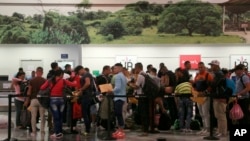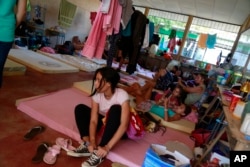Nearly 200 Cuban migrants who recently arrived in southern Mexico after being stranded several months in Costa Rica began making plans Thursday to travel to the border with the United States.
Migrant Manuel Rivero Oliva, reached by telephone early Thursday at a hotel in the southern city of Tapachula, said he and his cousin Alexei Oliva were headed to the airport there to buy plane tickets, hopefully for Friday, to the border city of Matamoros across from Brownsville, Texas.
Rivero, a 27-year-old trying to reach Orlando, Florida, said Wednesday's travel had gone smoothly and that in about an hour they received the paperwork needed to travel through Mexico.
“It was all really fast. They [Mexican immigration officials] were well prepared with a team there waiting for us. It's a blessing,'' Rivero said. “It was a beautiful thing to know there are so many people supporting us.''
His cousin, Alexei Oliva, 28, who planned to travel to Michigan once they reach the U.S., said most of their countrymen had spent the night in shelters in Tapachula and planned to continue north by bus. Oliva said he left Cuba on Oct. 27, flying first to Ecuador where he worked for a time to save money to continue.
On Wednesday, the 180 Cubans descended one by one from chartered buses and were processed by Mexican authorities, who issued transit visas granting them 20 days to leave the country.
Sergei Acosta, a 35-year-old farmer, was the first of the Cubans to set foot on Mexican soil.
He said he was elated despite a long night of travel by plane from Costa Rica to El Salvador, and from there by bus through Guatemala to Ciudad Hidalgo in Mexico.
“I'm very excited to have arrived,'' Acosta told The Associated Press.
He said he left Cuba in search of economic opportunity, and was optimistic about landing a job in the United States and then sending for his wife and daughter to join him.
“It's the need to have a better life,” he said.
8,000 Cubans trapped
The air and bus bridge is the first stage of a pilot program to relieve a logjam of some 8,000 Cubans who have been trapped at the Costa Rican border with Nicaragua, a close ally of the Havana government, after it closed its frontier to them on Nov. 13.
The first flight took off from the northern Costa Rican city of Liberia late Tuesday as part of a regional agreement to overcome Nicaragua's refusal to let them through by land.
The migrants were greeted by El Salvador's foreign minister upon arrival in that country even as, when they got to the Guatemalan border, they saw a busload of Salvadoran migrants headed the other way after being deported back from the United States.
The Cubans won't have to worry about that due to a U.S. immigration policy that lets them stay if they reach the United States.
That special status initially raised some resentment in Central America nations whose citizens are often deported from the U.S. if they enter without visas.
Officials have said that while they arranged the logistics for the first of the Cubans to leapfrog Nicaragua, it was up to the migrants to cover the cost of their passage.
For most Central American migrants, the trip takes weeks or months.
Emigration from Cuba has spiked dramatically in the year since Havana and Washington announced they would restore diplomatic relations. Many Cuban migrants say they're making the journey now for fear that detente could bring an end to the U.S. policies that have given them privileged treatment.
Backers of United States' Cuban Adjustment Act say it offers refuge to islanders fleeing Cuba's communist system.
Havana argues that the policy encourages Cubans to risk dangerous migratory voyages and causes a brain drain of many the country's youngest and brightest.











